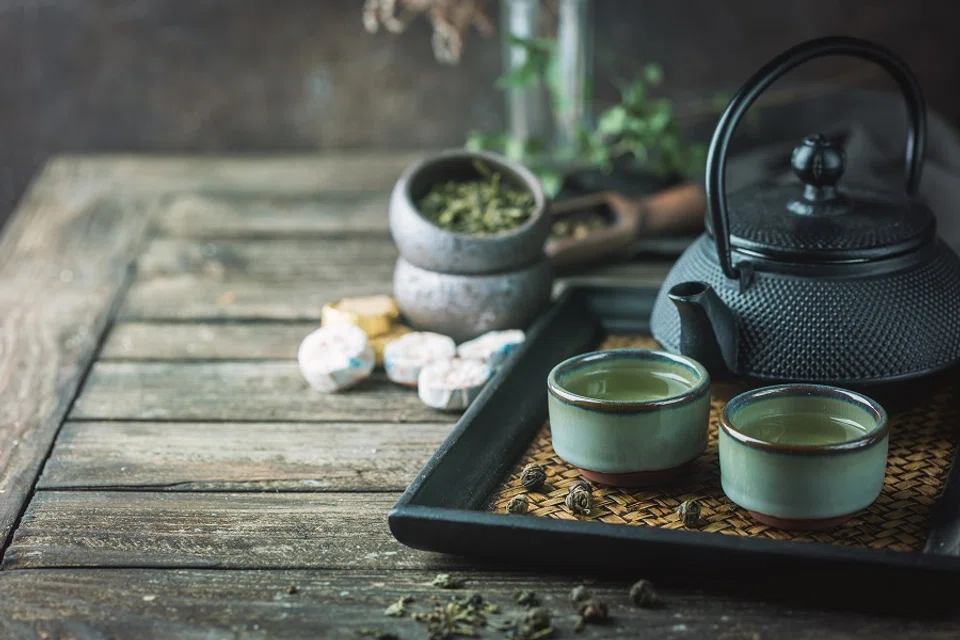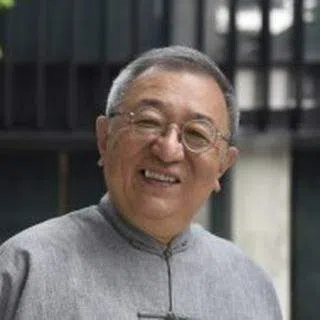How to drink tea like an ancient Chinese
Smoked bean tea, ghee tea or jade porcelain ground tea, anyone? Cheng Pei-kai turns tea-drinking conventions on their head as he shows that in history, tea appreciation was not just the domain of the sophisticated or the elegant. Common folk throughout the dynasties found innovative ways to have a cuppa, often with more than a few surprises tossed in.

I've got a friend who is a tea connoisseur. He becomes a different person once he steps into a teahouse. He becomes refined and sophisticated like the lily magnolias that grow in deep valleys or the black-naped oriole that soars out of the forest - his every move is elegant and poised, and so is every word that comes out of his mouth.
He said to me, "When a tea connoisseur drinks tea, he pays special attention to elegance. This means, the mind thinks elegant thoughts, the person has sophisticated interests, the mouth speaks refined words, the nose smells delicate scents, the tongue tastes refined flavours, and the body is poised and proper." I was speechless and could only take the tone of Chinese philosopher Zhuangzi and say, "Yes, that's true elegance and authentic sophistication. It's the elegance of the righteous and not something the layperson can understand."
Lu Yu (Tang dynasty Tea Sage) lamented that the tea a layperson drank - tea that had fruits, spices and herbs infused in them - was no different from sewage. Yet, that was how the layperson drank tea, and they would not change their ways.

Poised scholars of the ancient times have taught us that drinking tea is an elegant art that should not be crass; one can't be wilful and do it any which way one likes to. In Record of Tea (《茶录》, written in the Song dynasty), Cai Xiang (1012-1067) said that tea should not be mixed with any fruit or herb as it has a natural fragrance. Doing so would be going against tea's true nature. His view is in line with that of Tang dynasty Tea Sage Lu Yu's, and the art of tea drinking espoused by literati and scholars of the Tang and Song dynasties.
Chapter six of Lu's The Classic of Tea (《茶经》) discusses ways of drinking tea. A sentence reads: "Or they would add onions, ginger, red dates, orange peel, Cornus canadensis (Bunchberry Dogwood), mint and so on into tea, boil it for a long time and then strain it or remove the foam after it has been boiled. Such tea is no different from wastewater that flows down the drains. But this is how it's usually done!" Here, Lu lamented that the tea a layperson drank - tea that had fruits, spices and herbs infused in them - was no different from sewage. Yet, that was how the layperson drank tea, and they would not change their ways.
A poem Su Zhe (1039-1112) wrote to his elder brother, the Song dynasty poet Su Shi (1037-1101) talked about the northerners not knowing how to drink tea, and how their uncivilised ways were a far cry from the elegant rituals of tea appreciation practised by scholars.

It seems that only scholars heeded Lu's elaborate art of tea appreciation. Most people would probably think: "I'm not a tea connoisseur. Why should I go to such trouble just to drink tea when I am thirsty? Whether it's Lu or Cai, whether it makes perfect sense, I'll drink my tea just the way I like it."
A poem Su Zhe (1039-1112) wrote to his elder brother, the Song dynasty poet Su Shi (1037-1101) talked about the northerners not knowing how to drink tea, and how their uncivilised ways were a far cry from the elegant rituals of tea appreciation practised by scholars. A line in the poem reads: "You haven't seen just how superior the tea of Fujian's middle region is. The people take pride and find immense joy in brewing such tea. You also haven't seen just how many different types of tea the northern barbarians drink. They add salt, cheese, pepper, and ginger into tea and can still sing high praises of them."
Commoners and their uncommon ways of enjoying tea
Such unrefined tea-drinking practices were not unique to the northerners - common folk in the South drank tea in this manner too. Wu Zimu wrote in the Mengliang Lu (《梦粱录》) that teahouses in the cities of the Song dynasty were popular among the people. The teahouses of Southern Song's capital Lin'an (today's Hangzhou) sold all sorts of peculiar teas and bizarre soups. In the winter, they even sold "seven-treasure lei cha" (七宝擂茶).

Speaking about peculiar teas and bizarre soups, Southern Song's Zhao Xihu talked about different flowers that could be blended into tea in Tiao Xie Lei Bian (《调燮类编》, an ancient culinary encyclopedia): " Sweet osmanthus, jasmine, rose, multiflora rose, orchid, tangerine flowers, gardenia, banksia rose, and plum blossom."
As for the seven-treasure lei cha, we see a record for lei cha in Quxian Shenyin (《臞仙神隐》), a book written by prince Zhu Quan in the early Ming dynasty. Lei cha is a type of gruel made by pounding mecha (芽茶 or bud tea) - that has been soaked in soup - with stir-fried sesame. Ground pepper, salt, and pastry dough are then added and blended. If the mixture is too dry, tea soup is added. If pastry dough is unavailable, it can be replaced with dried noodles. The mixture is then stir-fried in a pan and topped with chestnut slices, pine nuts, or walnuts. A similar record can also be found in Duoneng Bishi (《多能鄙事》), a book about daily activities written in the Ming dynasty.
Evidently, ordinary people couldn't care less if they were drinking tea elegantly or not. Lu Yu's earnest advice and teachings on drinking tea have simply fallen on deaf ears with the common folk coming up with endless new ways of consuming tea.
It didn't matter if the condiments were salty, sweet, sour, or bitter - the more the merrier.

A look at Yinshan Zhengyao (《饮膳正要》, a Yuan dynasty book on food and nutrition by Hu Sihui, completed in 1330) shows us just how innovative the people were in drinking tea: wolf-berry tea, made from tea powder and dried wolf-berry powder mixed thoroughly with ghee; jade porcelain ground tea (玉磨茶), made from grinding superior purple tea buds and fried rice grains together in a jade porcelain stone mill; and ghee tea, made by mixing ghee and tea in boiling water.
Ghee tea came about as early as Lu's era. It has been passed down for generations and became popular among common folk during the Tang, Song, Yuan, and Ming dynasties. The northern nomads such as the Khitan, Jurchen, and Mongolians, especially loved such tea which meant that the tradition was in no danger of dying out. The Jin Ping Mei Cihua (《金瓶梅词话》) also records that such tea-drinking methods were still the norm among the northern people even in the mid to late Ming dynasty.

Age-old tea traditions live on
Jin Ping Mei Cihua is set in the Shandong region during the mid-Ming dynasty. It describes in detail the social life back then. Writing about the eating habits of the characters surrounding male protagonist Ximen Qing, we see a plethora of ingredients that were blended into tea: pine nuts and walnuts; Chinese olive cured in honey; candied orange peel; salted bamboo shoots, sesame, and osmanthus; plum and osmanthus julep over melon seeds; osmanthus and kumquat; hazelnuts and pine nuts; osmanthus, sesame, and smoked bamboo shoots; osmanthus and green beans; walnuts with salted bamboo shoots; sprinkles of smoked beans; salty cherries; eight-treasure green beans with osmanthus; seeds, shredded chestnut, salted bamboo shoots, sesame, and rose; ginger; potato; coriander and sesame; and so on.
From this non-exhaustive list, we can imagine just how random the methods of the Jin Ping Mei Cihua characters were in making tea. It didn't matter if the condiments were salty, sweet, sour, or bitter - the more the merrier. The most unimaginable and bizarre tea has to be this: mecha tea with sesame, salted bamboo shoots, shredded chestnut, seeds, walnuts with jasmine, osmanthus, rose, and que she (雀舌, sparrow's tongue) tea leaves. It's almost like pouring everything displayed on the shelves of the provision shop and dried fruit store into a pot and brewing a concoction of who knows what.

Most Suzhou scholars who lived in the same era as the Jin Ping Mei Cihua disagreed with the tea-drinking methods of the northern region. Cha Pu (《茶谱》, a book about tea, written by Qian Chunnian and Gu Yuanqing, completed in the Jiajing period, illustrates this pretty clearly and in much detail:
Tea has its natural fragrance, original taste, and authentic colour. When brewing tea, refrain from adding fruits and herbs to it. Ingredients like pine nuts, oranges, almonds, lotus seeds, banksia rose, plum blossoms, jasmines, multiflora roses, and osmanthus take away its fragrance. Ingredients like milk, saturn peaches, lychees, longan, pears, and loquats take away its taste. Ingredients like persimmon, red dates, peaches, Chinese bayberries and oranges take away its colour. Superior tea can only be tasted when it is without any other ingredients. Its distinctive taste becomes indiscernible if something is added. If something must be added, here are some ingredients that are still acceptable: walnuts, hazelnuts, melon seeds, red date seeds, water chestnuts, Indian almonds, chestnuts, Gorgon fruit, ginkgo, Chinese yam, dried bamboo shoots, sesame, sweet wormwood, lettuce, and celery.
Comparing this list with the one in Jin Ping Mei Cihua, many of the ingredients are taboos in drinking tea. However, there are also some that the scholars can somewhat accept, such as walnuts, hazelnuts, and melon seeds.
"They filled the cups to the brim with all kinds of fruits and ingredients, added some tea, and called this a 'fruit tea'. " - Ru Dunhe, 18th century

The seven-treasure lei cha brewed in Hangzhou's tea houses during the Southern Song dynasty was still popular among the people of Zhejiang in the Ming and Qing dynasties, with various names, such as fruit teas, gaocha (tall tea), and original teas. Until today, people living in the countryside of Zhejiang still drink green bean tea and smoked bean tea. Apart from adding smoked green beans into tea, people also added other ingredients at random in a show of good hospitality to special guests at home.
In the book Yue Yan Shi (《越言释》, written in the 18th century), Ru Dunhe expressed great displeasure with such uncivilised tea-drinking methods: "How preposterous and absurd this is! Yet, the barbarians think that this is a show of respect and hold it in high regard." He criticised the Zhejiang people for adding red ginger slices, lotus seeds, hazelnuts, and longan into tea: "They filled the cups to the brim with all kinds of fruits and ingredients, added some tea, and called this a 'fruit tea'. They hosted banquets for their guests with colourful fruits carved in the shape of phoenixes and mythical birds, and thought it was incredibly beautiful. Such tea is very expensive, and thus called gaocha. But this type of tea is there for ornamental value only, rather than to be enjoyed."
To tea connoisseurs particular about sophistication and elegance, pouring rose wine over Longjing tea plucked before Qingming Festival (明前龙井), or adding brown sugar ginger juice into Biluochun tea (碧螺春) are gross misuses of premium-grade tea leaves. However, these were folk customs, and the literati and scholars could hardly do anything about it.



![[Photos] Fact versus fiction: The portrayal of WWII anti-Japanese martyrs in Taiwan](https://cassette.sphdigital.com.sg/image/thinkchina/3494f8bd481870f7c65b881fd21a3fd733f573f23232376e39c532a2c7593cbc)

